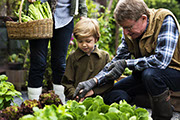Project House
Housing is a fundamental need we all have, whether it is temporary or permanent. Having a safe, clean and secure place to rest our heads, nourish and care for ourselves is vital to both physical and mental health.
Project House was inspired by many years of witnessing issues surrounding Farm Worker Housing. My personal experience with the task of identifying available housing concepts and developing a successful housing project brought me face to face with the challenges.
The history, creative forms, capacity for community acceptance and benefits of housing are important to understand if you are considering a housing project. Identifying the array of possibilities as well as challenges faced by those committed to finding a way may be helpful in your quest.
It is my hope that this information will help bring more awareness to all stakeholders and provide collaboration for future successes. The creative efforts developed by many across the Country may find there way to those who are searching for ideas.
There are many ways to slice the cake. This material will share concepts previously considered and applied to develop farm worker housing in a safe and economically viable way.
Agriculture’s housing needs vary on size of operation, location and type of work force needed and duration of that workforce both seasonal and year round.
In the end this is not intended to be the only resource you will need but should get you started in the right direction and asking the right questions.
Commentary by Luawanna Hallstrom



